As an Amazon Associate, I earn from qualifying purchases.
Learn the secrets to Removing Rust From Cast Iron without toxic chemicals or harsh treatments. You’ll also learn how to clean and season cast iron, and LOVE your skillets and dutch ovens.
There are a few tools that every cook should have in their kitchen – a great set of knives, a heavy-duty stand mixer, a food processor, stainless steel nesting mixing bowls, a dutch oven, and a cast iron skillet.
Cast iron is one of those things that people either LOVE, or it scares the beejesus out of them because they don’t understand it. The common complaints people have against cast iron:
1) “it rusts”
2) “they’re heavy”
3) “I don’t know how to use it and food always sticks.”
Today, I’m here to convince you that cast iron rules and belongs in your kitchen!
Benefits of Cast Iron
- Cast iron cookware is durable. It’s not uncommon to find people using the pans they inherited from their granny.
- Many are made in the USA (Lodge brand)
- It distributes heat evenly. And you can (and should) cook on lower heat using cast iron. Lower heat = lower energy bills.
- It can help add iron to your diet.
- It cooks food beautifully. Roasted veggies and cornbread are 100% better when cooked in cast iron than something else. FACT.
- It can go from stovetop to oven, to a campfire if necessary.
- Once properly seasoned, you don’t REALLY have to wash cast iron.
Removing Rust From Cast Iron
If you’ve ever passed over a rusty skillet at a thrift shop or garage sale, STOP! Those pans are not beyond repair and with a little elbow grease, they can become a family heirloom.
Step One:
Clean the skillet with soap and water. In my humble opinion, this is one of the last times your skillet should need soap.
Step Two:
Give it a 10-minute steam bath in a 350-degree oven.
Step Three:
Using a rag you don’t mind getting dirty, paper towels, or pieces of newspaper, work the oil and salt into all parts of the skillet. Pay special attention to the rusty areas.
Pro tip: you can also use a potato cut in half to scrub the salt into the skillet. Potatoes contain oxalic acid which is a natural rust remover. Steel wool can also be used for removing rust from cast iron.
Light rust is called profile rusting. If you have a more stubborn rust situation, we’ll talk about that below.
Step Four:
Carefully wipe out the extra oil from the skillet using paper towels. Using another paper towel, work any remaining oil around to cover the entire surface of the skillet. Lightly oil the outside and the handle.
Make sure to remove all excess oil from the pan. There should be no puddling or obvious pooling of oil. Pro tip: if you leave too much oil on the pan, during the seasoning process in step five your pan will likely develop a sticky residue.
Step Five:
Flip the pan upside down and place it on the top rack of your oven. Bake for 90 minutes at 350 degrees. Some people may recommend putting down a piece of foil or a baking sheet on the rack under the skillet while it bakes.
If you removed all the extra oil like advised, this isn’t necessary. But if it gives you peace of mind to keep your oven extra clean then totally do it.
Pro tip: this will create some smoke in your kitchen. Make sure to turn on your vent hood and maybe crack a window to help. My husband has asthma and the odor does bother him so I will only season cast iron when he is out of the house.
Allow it to cool in the oven and then repeat step four and five until the surface is non-stick (1-4 total cycles depending on the state of the skillet when you started).
After round one in the oven:
After round two in the oven:
What is the best oil to season a cast iron skillet?
You’ll need a high heat oil for seasoning cast iron. A few of the oils that are considered safe at temps over 300 degrees F are:
- Almond
- Avocado
- Canola
- Coconut
- Grapeseed
- Safflower
- Sunflower
- Vegetable
Depending on your dietary needs (specifically, AIP, paleo, and Whole30), some of these oils may not be considered a good choice.
How to Remove Excessive Rust From Cast Iron
Option 1: If the rust is REALLY stubborn, put the skillet in the oven on the self-clean cycle. This will strip everything from the pan and give you a blank slate to reseason.
Then wash with hot soapy water and follow steps four and five.
Option 2: You can also submerge it in a sink with 50% water and 50% white vinegar. Soak for 1-8 hours. Then wash with hot soapy water and follow steps four and five.
Option 3: Fill the skillet with regular Coke and let it sit overnight. Then wash with hot soapy water and follow steps four and five.
How to Cook In Cast Iron
Cast iron can be used for most dishes, but acidic foods such as vinegar and tomatoes should be avoided as they can eat away at your careful seasoning.
Never put food in a cold cast iron skillet. You’ll always want to preheat your cast iron over medium-low heat for a few minutes.
Before adding food you’ll need to brush some sort of fat (oil, butter, bacon grease, etc.,) on the cooking surface to help keep the pan non-stick.
One of the amazing benefits of cast iron is that you can start it on a burner and then pop it in the oven. We use that method for our Whole30 + Paleo Frittata. Cast iron is the ultimate tool for one-pan meals.
Cleaning a Cast Iron Pan After Use
After your delicious meal of Blistered Shishito Peppers, you can simply let the pan cool a bit and then wipe out any leftover oil with a paper towel. That’s right – no need to scrub, rinse or wash the skillet with soap and water.
You worked really hard to season your skillet. Soap will remove the careful seasoning and is not necessary. Never soak your cast iron or god forbid put it in the dishwasher!
I don’t think I have to explain to you how amazing it is to have one less dish to wash! Imagine whipping up a batch of Whole30 Skillet Fried Potatoes for brunch knowing that you don’t have to wash that dish.
Occasionally, the cooking process will leave some stuck on food that can’t be removed by gentle wiping. In that case, rinse the skillet under water and gently scrub it with a soap-free brush.
Lodge even makes a handy little chainmail wire scrubber specifically made for cleaning cast iron.
If you have to clean cast iron with water you’ll want to thoroughly dry your skillet and then quickly reseason it. This can be as simple as wiping a bit of oil into the pan and putting it on a warm burner for 10 minutes.
If your oven is still warm/hot from cooking, pop it in there after adding some oil and let it sit until the oven has cooled.
Routine Cast Iron Skillet Care
If you notice that your skillet is becoming less non-stick, follow steps 4 and 5 above to create an extra layer of seasoning on the cooking surface.
To save time and money, this is best done right after you’ve used the oven for cooking a meal. Or even while you’re using your oven for something else like baking bacon in the oven.
Example: you just made a batch Simple Shepherds Pie With Turkey. Once the food has been dished up, wipe the skillet out with a paper towel or clean kitchen rag. Apply a small amount of high heat oil to the skillet and buff it into the cooking surface with a clean paper towel.
Pop the skillet back into the still-warm oven and keep it there until it fully cooled. Routine cast iron skillet care and upkeep like this will keep your skillet in prime fighting shape. Or, you know, cooking shape.
Cast Iron Rust Prevention
Cast iron can be prone to rusting if stored improperly or put away before it is fully dried. Certain climates (coastal conditions and humidity) may require you to repeat steps 1-5 occasionally if profile rusting develops.
Storage: if you stack skillets in your cupboard, place a paper towel or piece of newspaper between each skillet. This prevents chipping and rust spots developing from skillet to skillet contact.
When To Throw Out Cast Iron
As durable as cast iron is, there are some pieces of cookware so mistreated that they are beyond repair and unsafe to use. Your cast iron should be tossed if there is deep pitting on the cooking surface, or there are cracks or chips in the pan.
Cast Iron Skillet Recipes
Now that you have a gorgeous seasoned skillet, let’s get cooking!
- Cast Iron Pizza
- Baked Cauliflower Patties
- Jalapeno Poppers Dip
- Crispy Oven-Roasted Butternut Squash
- Paleo Salmon Cakes
- Whole30 Quiche
- Whole30 Breakfast Sausage
- Fried Cabbage With Bacon
Removing Rust From Cast Iron {How to Season Cast Iron}

Ingredients
- 1 cast iron skillet
- 1 high heat oil
- 1 kosher salt
- paper towels or newspapers
Instructions
- Clean the skillet with soap and water.
- Give it a 10-minute steam bath in a 350-degree oven.
- When it is dry, carefully remove the pan from the oven and pour a puddle of high-heat oil (see list below) and a generous helping of kosher salt into the center.
- Using a rag you don't mind getting dirty, paper towels, or pieces of newspaper, work the oil and salt into all parts of the skillet. Pay special attention to the rusty areas.
- Rinse the salt out of the skillet. Put it on the stovetop on medium heat with a small amount of high-heat oil, and work it around with another rag. I use a pastry brush. Let it heat and "cure" for about 5 minutes.
- Carefully wipe out the extra oil from the skillet using paper towels. Using another paper towel, work any remaining oil around to cover the entire surface of the skillet. Lightly oil the outside and the handle.
- Make sure to remove all excess oil from the pan. There should be no puddling or obvious pooling of oil. Pro tip: if you leave too much oil on the pan, during the seasoning process in step five your pan will likely develop a sticky residue.
- Flip the pan upside down and place it on the top rack of your oven. Bake for 90 minutes at 350 degrees. Some people may recommend putting down a piece of foil or a baking sheet on the rack under the skillet while it bakes.
- If you removed all the extra oil like advised, this isn't necessary. But if it gives you peace of mind to keep your oven extra clean then totally do it. Pro tip: this will create some smoke in your kitchen. Make sure to turn on your vent hood and maybe crack a window to help.
- Allow it to cool in the oven and then repeat step four and five until the surface is non-stick (1-4 total cycles depending on the state of the skillet when you started).
Notes

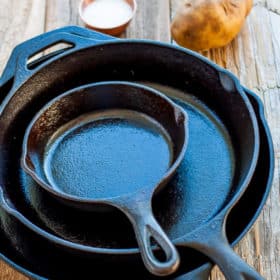
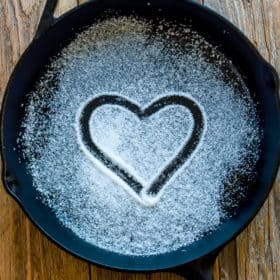
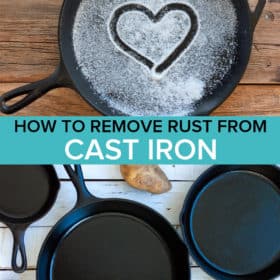
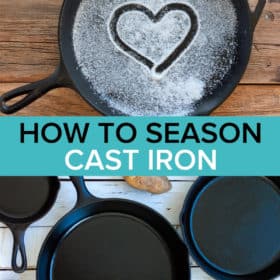
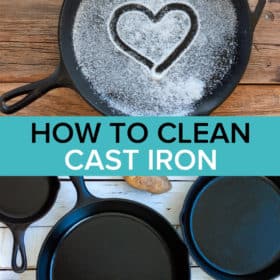
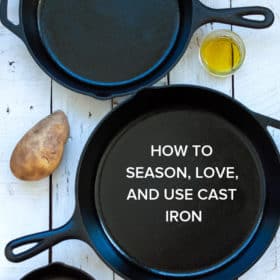
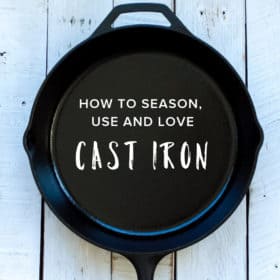

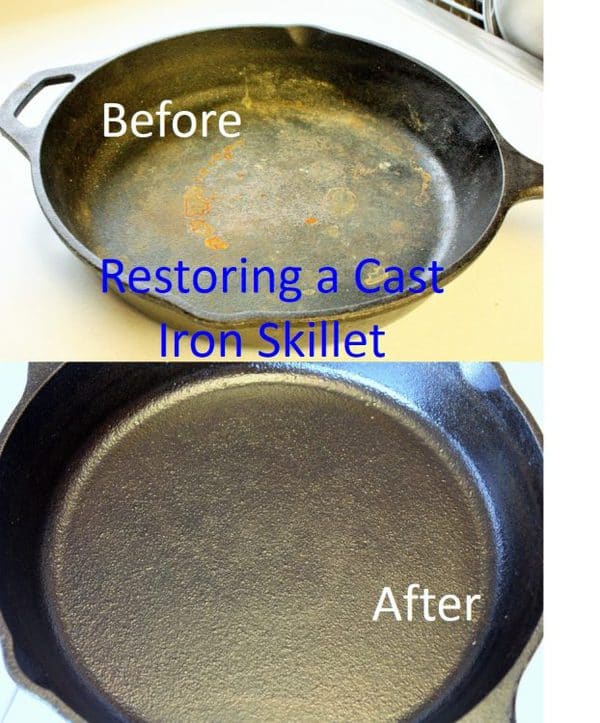
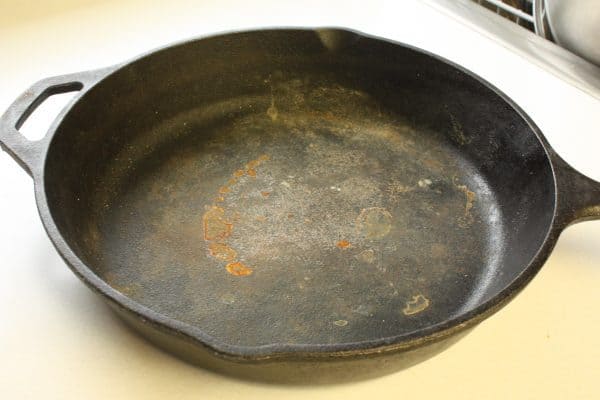
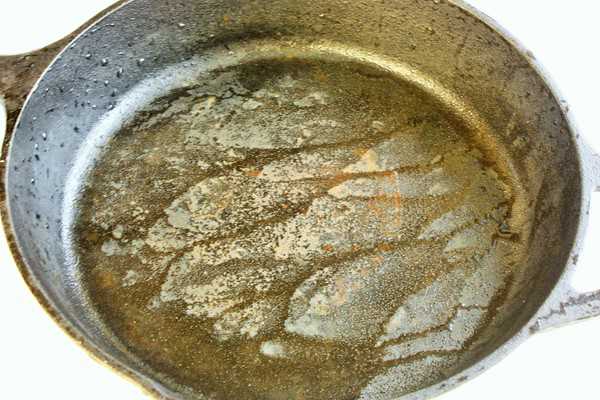
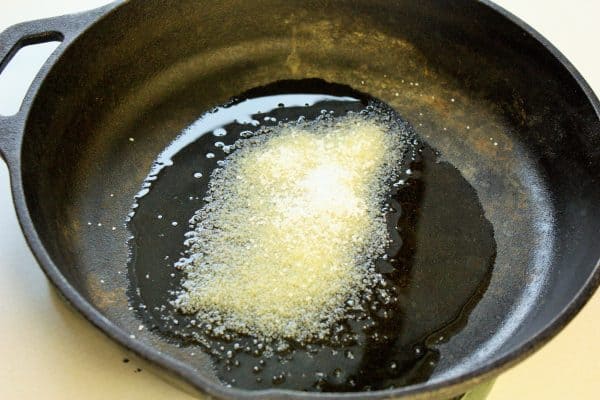
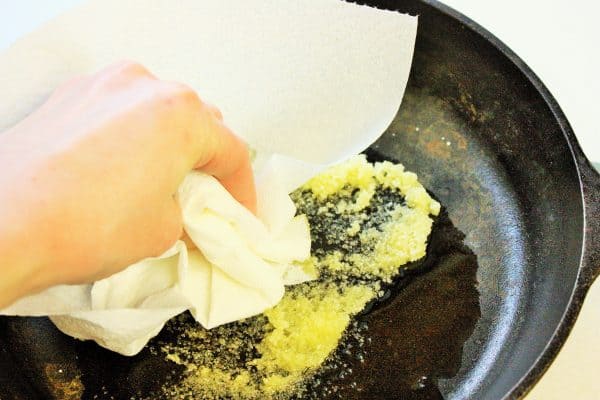
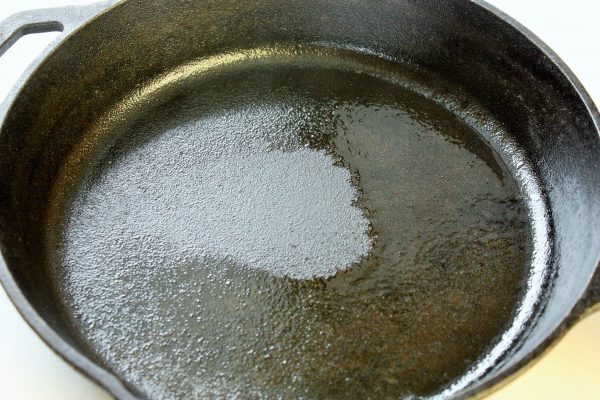
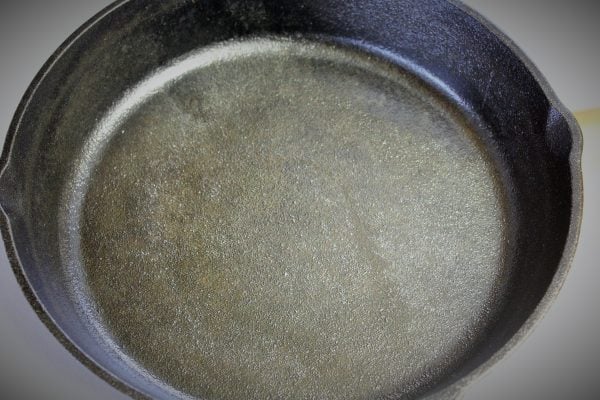
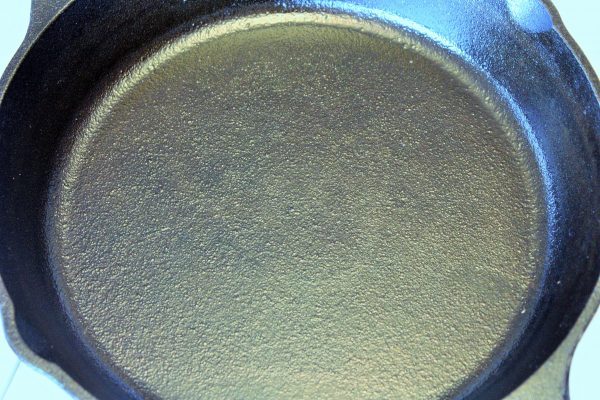
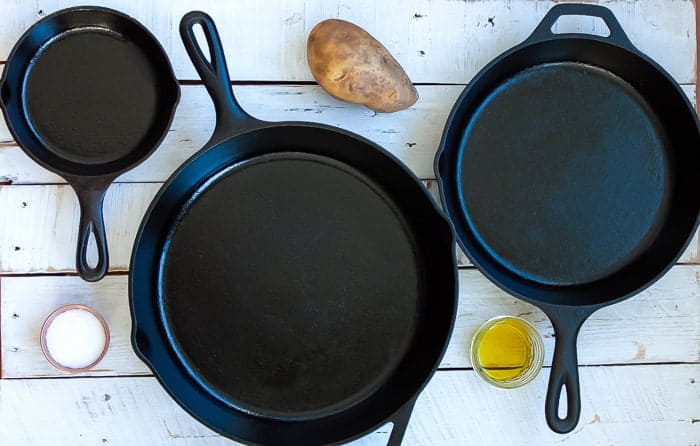
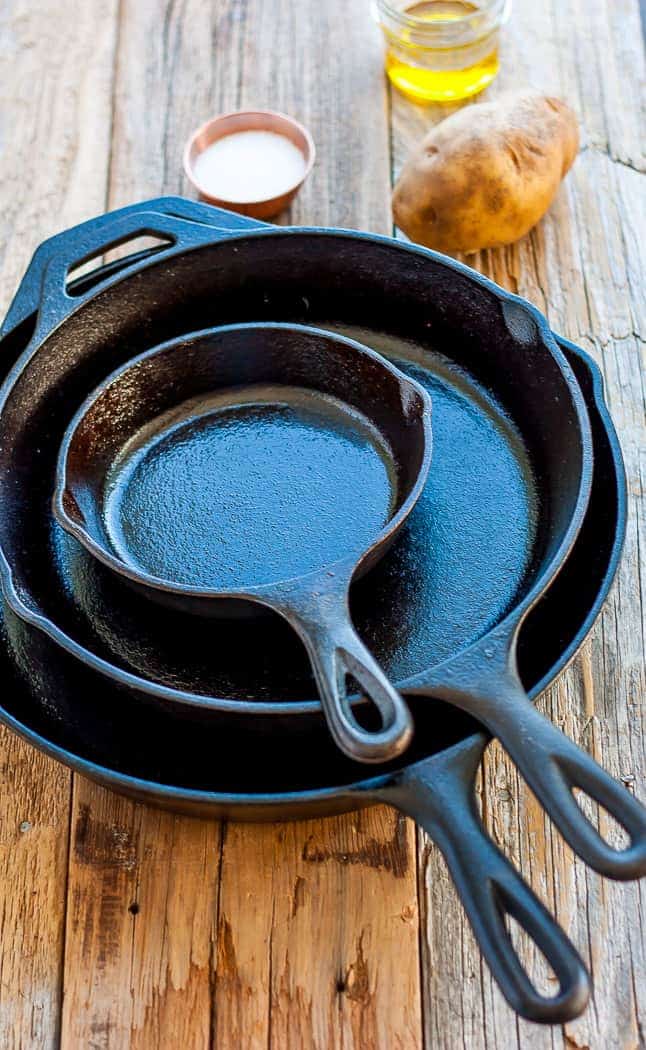
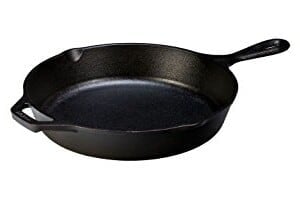
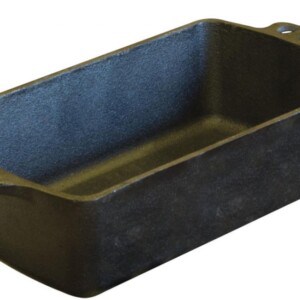
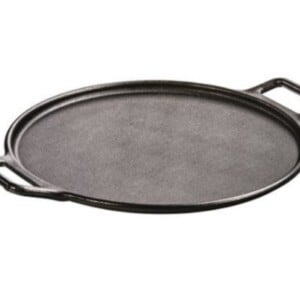
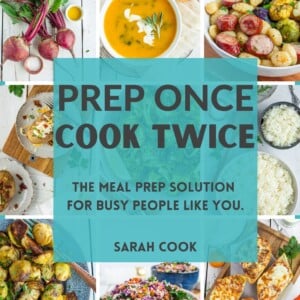






We hve 2 cast iron skillets that are completely rusted, inside and out. I was told to burn them until white then clean and season them. I am wondering if this would work for them without the “burn off” that I was told to do or is there something else that I should do with them to get them to a point where they can be used again?
Hmmm, I’ve never heard of that tactic, but I guess it could work. Since I have a glass top stove, I’d probably “burn” it on a fire or a BBQ to avoid smoke in the house and a messy stove.
Ohh ohh, better idea! “burn” one of them, and try the oil and kosher salt for the other. Then you can have a test and see which way works better!
If you google “seasoning cookware” and look at the wikipedia page, it gives you great information on what seasoning if for, why/how it works and there’s also a sentence about getting the old patina (seasoning, aka – the black stuff) off of pans ready to add new seasoning like in your post here.
I struggled with a pan from Value Village for 2 days before reading the wikipedia page and finally understanding what I should do! I ended up using some drain cleaner (in place of burning or lye) in water in my sink (gloves, ventilation, yadda yadda) and it took less than an hour this way.
Then I seasoned your way, Sarah, and it’s lovely! I also got the tip from the wikipedia page that you shouldn’t use acidic food (tomatoes, vinegar, etc) in a cast iron pan, as it will take the patina off.
I received 3 wonderful cast iron skillets about 10 years ago for a wedding gift. I was so excited, I thought I was seasoning them right, but I didn’t. I saved them because I was not able to let them go. What can I do to fix them? Any tips? Thanks!
What is wrong with them exactly? I’d strip them down using the method above and then just start over.
This is fantastic. I love my cast iron cookware but my kids keep washing it when they do the dishes, so the seasoning disappears. What advise can you give me for cleaning it after the cooking?
Well, I honestly don’t clean it after I cook it in. I wait for it to cool down, and then wipe it out with a paper towel. With the seasoning, nothing is sticking to it, and anything raw already cooked off of it.
That is why I love cast iron so much – one less thing to wash!
Thanks for sharing this post at Make-ahead Monday! I hope to see you again next week!
Sarah @ Raising Isabella
This is a great post! The last several years as I’ve been building my hope chest inventory I’ve worked with many a cast-iron uh.. *items* (Pans, muffin tins, grill pan, etc.) This is much simpler, and seemingly more efficient than what I’ve been doing!
So glad you found it useful!
Thank you so much for this post! I have never seen such a detailed or lengthy post on cleaning and seasoning a cast iron pan. I have the first of several in the oven right now following your directions. I “know” I’m not supposed to use soap on my pans, but my brain always says yes! Consequently, everything sticks when I use them. I will try my best to do better. Thanks again for this great post!
Step away from the soap!!!! ;-D
Let me know how the “cast iron spa” in your oven turns out. I hope your pans are gleaming and lovely.
Yes Sarah ~ my pans are gleaming and lovely. I used one last night to saute veggies and it was amazing, nothing stuck! I even “stepped away from the soap”!!! 3 down, 2 to go. Love it ~ thanks so much.
That is AWESOME!!!! So glad to hear it, and even more glad to hear that you stuck to your guns and steered clear of the suds!
I have this one on my to-do list! I would love for you to come share this recipe on my link-up, Make-ahead Mondays, at Raising Isabella!
Hope to see you there!
Sarah
This is too funny! Thank you for doing a thorough post on properly seasoning cast iron, I think I can finally fix up my old, sad pan!
I have read lots of tutorials on proper care of a cast iron skillet. This is, hands down, the best I’ve ever seen! Thanks for all the great pictures.
You’re very welcome! Glad you found it useful. Thanks so much for the kind compliment.
Sarah thank you very much for placing this post on Natural Mothers Network’s linky: Seasonal Celebration! You helped make Seasonal Celebration a wealth of intelligent, creative and resourceful information and it’s been such a pleasure for me and many others to read through each post. I am really looking forward to seeing you again Sunday evening or Monday! Rebecca x PS: Proud owner of newly refurbished skillet!
Thanks for the invite! Glad to hear your skillet got a trip to the “spa”.